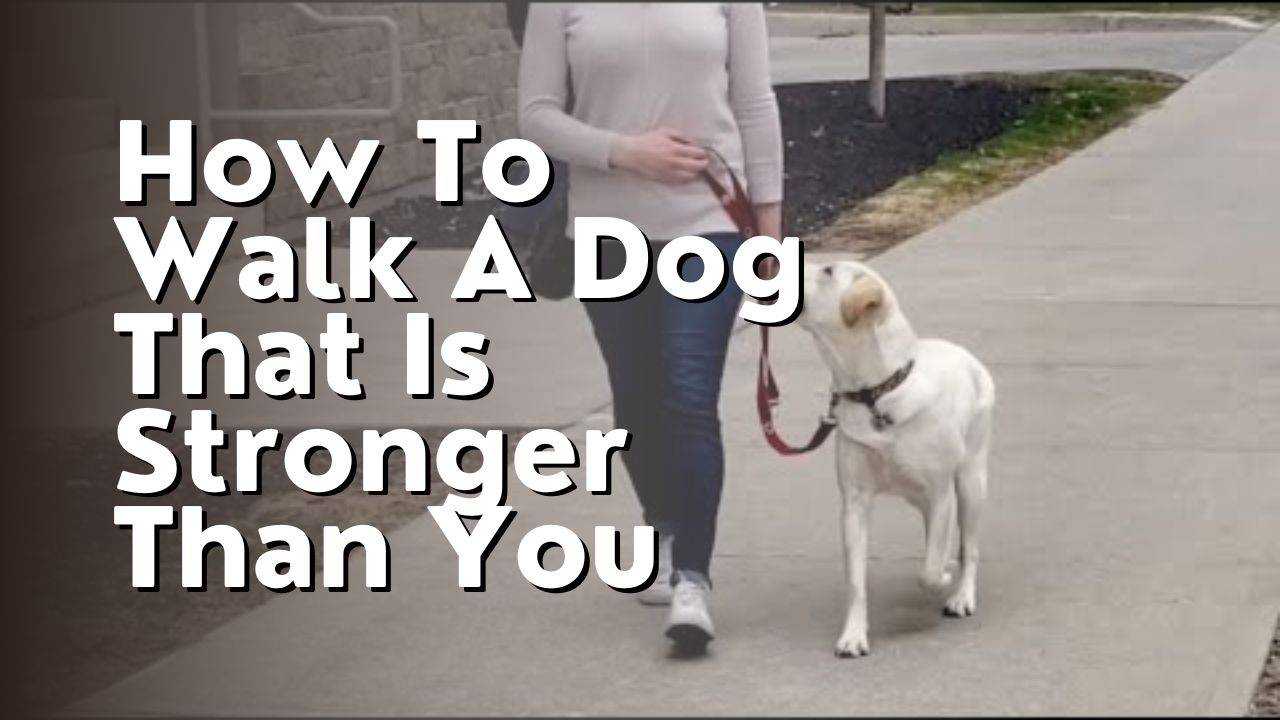So you’ve found yourself with a furry friend who is a bit on the stronger side, huh? Well, fear not, because I’m here to help you navigate the world of walking a dog that can easily overpower you. Trust me, I’ve been there.
In this article, we’ll dive into the essential tips and techniques that will make your walks with your strong pup a breeze. From choosing the right leash and harness to practicing proper handling techniques, we’ve got you covered.
We’ll also explore how to train your dog to walk politely on a leash and discuss useful tools and techniques for managing pulling.
Of course, every dog is unique, so we’ll touch on when it might be necessary to seek professional help.
So grab a cup of coffee, sit back, and get ready to conquer those walks with your strong-willed dog. Together, we’ve got this!
Choose the Right Leash and Harness
Now, you want to make sure you’ve got the right leash and harness for your pup. When walking a dog that is stronger than you, it’s important to have the proper equipment to ensure both your safety and your dog’s comfort.
First, let’s talk about the leash. Opt for a sturdy leash made of durable material like nylon or leather. Avoid retractable leashes as they can give your dog too much freedom and make it harder for you to control them. Instead, choose a leash with a standard length that allows you to maintain control and keep your dog close to you.
Next, consider the harness. A good harness distributes the pulling force more evenly across your dog’s body, reducing the strain on their neck and making it easier for you to handle them. Look for a harness that has a front clip attachment, as it gives you more control by redirecting your dog’s attention toward you when they pull.
Additionally, make sure the harness fits your dog properly. It should be snug but not too tight, allowing your dog to move comfortably while preventing them from slipping out.
By choosing the right leash and harness, you’ll be setting yourself up for success when walking a strong dog. Remember, always prioritize safety and comfort for both you and your furry friend.

Practice Proper Leash Handling Techniques
Mastering proper leash-handling techniques will make your furry companion’s daily strolls a breeze. It’s important to have full control and be confident when walking a dog that is stronger than you. Here are some tips to help you handle the leash like a pro:
- Hold the leash with a firm grip: Make sure you hold the leash securely but avoid pulling too hard. A relaxed grip will allow for better control and prevent any discomfort for both you and your dog.
- Maintain a short leash: Keeping the leash short will give you more control over your dog’s movements. It prevents them from wandering off or pulling you too far ahead.
- Use your body as a barrier: If your dog tends to pull or lunge, position your body to block their path. This will help redirect their attention and prevent them from pulling you off balance.
- Practice proper leash corrections: Instead of yanking on the leash, use gentle, quick tugs to correct your dog’s behavior. This helps them understand what you expect from them without causing any harm.
By incorporating these techniques into your daily walks, you’ll be able to confidently handle a stronger dog and enjoy your time together. Remember, consistency and patience are key when it comes to training your furry friend.
Train Your Dog to Walk Politely on a Leash
Improve your daily walks by teaching your furry companion to politely stroll by your side on a leash. Training your dog to walk politely on a leash is essential, especially if your dog is stronger than you. It not only ensures your safety but also creates a positive walking experience for both of you.
First, start by establishing a strong foundation with basic obedience training. Teach your dog commands like ‘sit,’ ‘stay,’ and ‘heel.’ Consistency is key here, so practice these commands daily. Once your dog has mastered these basic commands, you can move on to leash training.
Begin by introducing your dog to the leash in a calm and positive environment. Allow them to sniff and investigate the leash before attaching it to their collar. Next, start by walking short distances in a quiet area. Use treats and praise as rewards for walking nicely by your side. Gradually increase the distance and add distractions to the environment.
If your dog pulls on the leash, stop walking and wait for them to calm down. Resume walking only when the leash is loose. Remember to be patient and give your dog time to learn.
Incorporate regular training sessions into your walks to reinforce good behavior. Consistency, positive reinforcement, and patience are key to teaching your dog to walk politely on a leash. With time and practice, your dog will become a well-behaved walking partner, regardless of their strength.
Use Tools and Techniques to Manage Pulling
To effectively manage to pull, I equip myself with tools such as a no-pull harness or gentle leader and practice techniques like using treats to redirect my pup’s attention. These tools and techniques have been a game-changer for me when it comes to walking a strong dog.
Firstly, I use a no-pull harness or gentle leader to give me more control over my dog’s movements. These tools distribute the pressure evenly and discourage pulling. The no-pull harness attaches at the front, redirecting the dog’s forward momentum when they pull. The gentle leader, on the other hand, goes around their muzzle, giving me control over their head movements. Both options have helped me immensely in managing my dog’s strength during walks.
Secondly, I employ the technique of using treats to redirect my pup’s attention. Whenever my dog starts to pull, I hold a treat near their nose, and as they turn their attention to the treat, I guide them in the desired direction. With consistent practice, my dog now associates pulling with a delicious treat and is more likely to walk calmly beside me.
By using tools like a no-pull harness or gentle leader and employing techniques such as treat redirection, I have found a way to effectively manage my strong dog’s pulling during walks. It has made our walks much more enjoyable and has strengthened our bond along the way.

Seek Professional Help if Needed
If necessary, consider seeking the assistance of a professional trainer or behaviorist to address any persistent issues with pulling on the leash. Sometimes, despite our best efforts, we may find ourselves struggling to handle a dog who is stronger than us. In these situations, it is crucial to recognize when it’s time to ask for help.
A professional trainer or behaviorist has the knowledge and experience to assess the situation and provide you with the necessary tools and techniques to manage your dog’s pulling behavior.
A professional can work with you and your dog to identify the underlying causes of the pulling and develop a customized training plan. They can teach you how to properly use equipment such as harnesses or head halters to gain better control over your dog. Additionally, they can help you understand your dog’s body language and signals, allowing you to communicate more effectively with them during walks.
Seeking professional help is not a sign of failure but rather a proactive step towards improving your dog’s behavior and creating a safer and more enjoyable walking experience for both of you. Remember, it’s important to set realistic expectations and be patient throughout the training process.
With the guidance of a professional, you can build a strong foundation of trust and communication with your dog, making walks a much more pleasant and manageable activity.
Frequently Asked Questions
How do I choose the right leash and harness for my strong dog?
I choose the right leash and harness for my strong dog by considering its size, strength, and behavior. I look for a sturdy and durable leash with a comfortable harness that provides control and prevents pulling.
What are some proper leash-handling techniques I can use when walking my strong dog?
To handle my strong dog on a leash, I employ proper techniques. I maintain a firm grip, hold the leash close to my body, and use short, controlled movements. This ensures my dog’s safety and gives me control during walks.
How can I train my strong dog to walk politely on a leash?
I can train my strong dog to walk politely on a leash by using positive reinforcement and consistent training. I will start by teaching basic commands like “heel” and reward him when he walks calmly beside me.
What are some tools and techniques I can use to manage my strong dog’s pulling?
To manage my strong dog’s pulling, I use a front-clip harness or head collar for better control. I also employ techniques like stopping and changing directions when he pulls, rewarding good behavior, and gradually increasing leash training.
When should I seek professional help for walking my strong dog?
I should seek professional help for walking my strong dog when I feel overwhelmed or unable to control their pulling behavior. A professional trainer can provide guidance and teach techniques to ensure a safe and enjoyable walking experience.
Conclusion
Walking a strong dog that is stronger than you can be challenging. However, with the right leash, proper handling techniques, and training, it can become a pleasant experience.
First, make sure you have a sturdy leash that provides you with a good grip. A leash made of strong material, such as nylon or leather, can help you maintain control.
Next, practice proper handling techniques. Hold the leash close to your body and keep a firm grip. Avoid wrapping the leash around your hand or wrist, as this can lead to injuries if your dog pulls suddenly.
When walking, be proactive and anticipate your dog’s movements. If you sense that your dog is about to pull, stop walking and stand still. This sends a clear message to your dog that pulling is not acceptable. Once your dog relaxes and the tension on the leash is released, you can continue walking.
Using tools and techniques to manage pulling can also be helpful in controlling your dog’s strength. For example, a front-clip harness can redirect your dog’s attention toward you when they pull. Additionally, teaching your dog loose leash walking techniques, such as rewarding them for walking by your side, can encourage them to stay close to you.
If you find yourself struggling to control your strong dog, don’t hesitate to seek professional help. A dog trainer or behaviorist can provide you with personalized guidance and techniques to address the specific challenges you’re facing.
Remember, a well-behaved and well-exercised dog is a happy dog. Put in the effort to train and exercise your dog, and enjoy your walks together.


